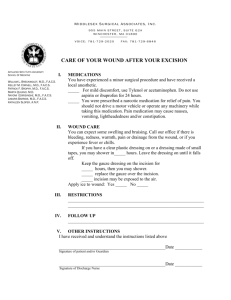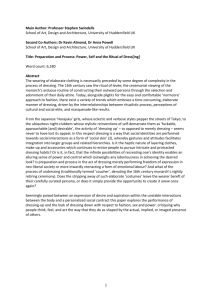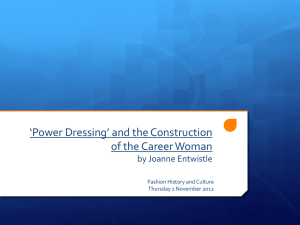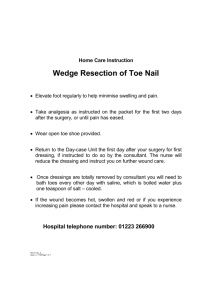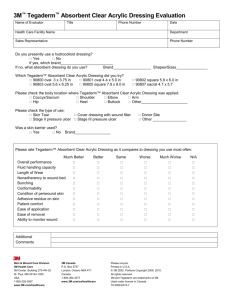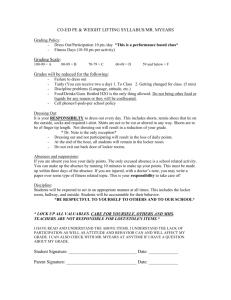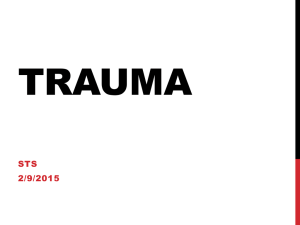Nature and Types of Abusive Behaviors against Women
advertisement
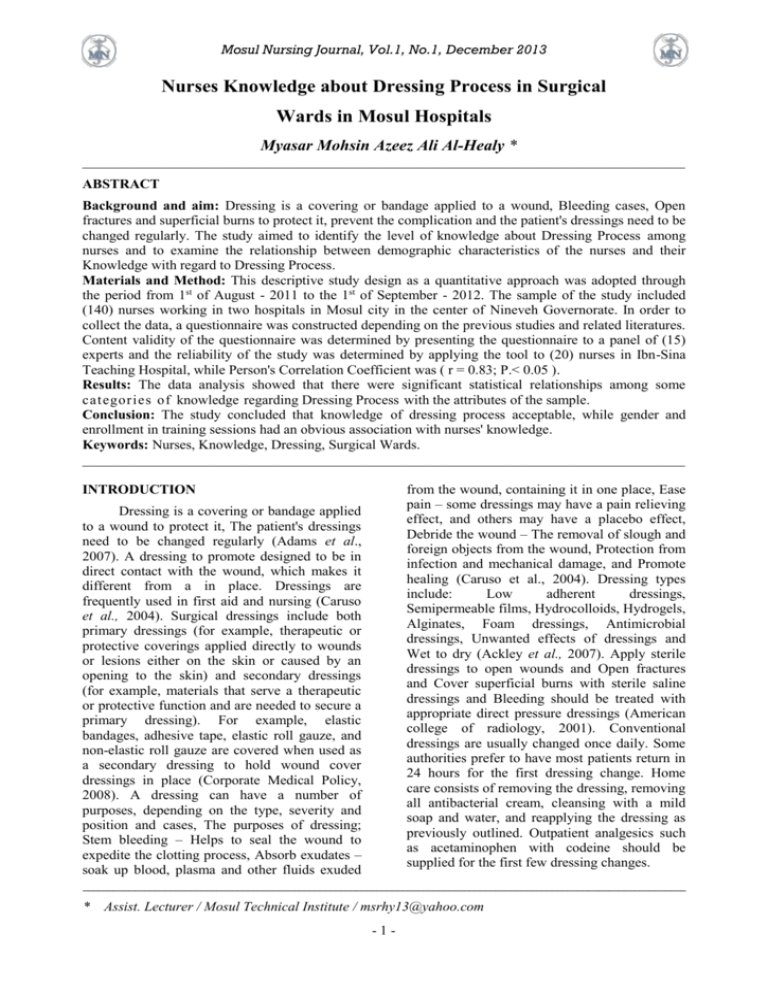
Mosul Nursing Journal, Vol.1, No.1, December 2013 Nurses Knowledge about Dressing Process in Surgical Wards in Mosul Hospitals Myasar Mohsin Azeez Ali Al-Healy * _____________________________________________________________________________________ ABSTRACT Background and aim: Dressing is a covering or bandage applied to a wound, Bleeding cases, Open fractures and superficial burns to protect it, prevent the complication and the patient's dressings need to be changed regularly. The study aimed to identify the level of knowledge about Dressing Process among nurses and to examine the relationship between demographic characteristics of the nurses and their Knowledge with regard to Dressing Process. Materials and Method: This descriptive study design as a quantitative approach was adopted through the period from 1st of August - 2011 to the 1st of September - 2012. The sample of the study included (140) nurses working in two hospitals in Mosul city in the center of Nineveh Governorate. In order to collect the data, a questionnaire was constructed depending on the previous studies and related literatures. Content validity of the questionnaire was determined by presenting the questionnaire to a panel of (15) experts and the reliability of the study was determined by applying the tool to (20) nurses in Ibn-Sina Teaching Hospital, while Person's Correlation Coefficient was ( r = 0.83; P.< 0.05 ). Results: The data analysis showed that there were significant statistical relationships among some categories of knowledge regarding Dressing Process with the attributes of the sample. Conclusion: The study concluded that knowledge of dressing process acceptable, while gender and enrollment in training sessions had an obvious association with nurses' knowledge. Keywords: Nurses, Knowledge, Dressing, Surgical Wards. _____________________________________________________________________________________ from the wound, containing it in one place, Ease pain – some dressings may have a pain relieving effect, and others may have a placebo effect, Debride the wound – The removal of slough and foreign objects from the wound, Protection from infection and mechanical damage, and Promote healing (Caruso et al., 2004). Dressing types include: Low adherent dressings, Semipermeable films, Hydrocolloids, Hydrogels, Alginates, Foam dressings, Antimicrobial dressings, Unwanted effects of dressings and Wet to dry (Ackley et al., 2007). Apply sterile dressings to open wounds and Open fractures and Cover superficial burns with sterile saline dressings and Bleeding should be treated with appropriate direct pressure dressings (American college of radiology, 2001). Conventional dressings are usually changed once daily. Some authorities prefer to have most patients return in 24 hours for the first dressing change. Home care consists of removing the dressing, removing all antibacterial cream, cleansing with a mild soap and water, and reapplying the dressing as previously outlined. Outpatient analgesics such as acetaminophen with codeine should be supplied for the first few dressing changes. INTRODUCTION Dressing is a covering or bandage applied to a wound to protect it, The patient's dressings need to be changed regularly (Adams et al., 2007). A dressing to promote designed to be in direct contact with the wound, which makes it different from a in place. Dressings are frequently used in first aid and nursing (Caruso et al., 2004). Surgical dressings include both primary dressings (for example, therapeutic or protective coverings applied directly to wounds or lesions either on the skin or caused by an opening to the skin) and secondary dressings (for example, materials that serve a therapeutic or protective function and are needed to secure a primary dressing). For example, elastic bandages, adhesive tape, elastic roll gauze, and non-elastic roll gauze are covered when used as a secondary dressing to hold wound cover dressings in place (Corporate Medical Policy, 2008). A dressing can have a number of purposes, depending on the type, severity and position and cases, The purposes of dressing; Stem bleeding – Helps to seal the wound to expedite the clotting process, Absorb exudates – soak up blood, plasma and other fluids exuded _____________________________________________________________________________________________________________________ * Assist. Lecturer / Mosul Technical Institute / msrhy13@yahoo.com -1- Mosul Nursing Journal, Vol.1, No.1, December 2013 Follow-up visits with a primary care provider at 3 and 7 days are recommended, with more frequent visits for supervised dressing changes if compliance is a problem. The parent is instructed to return if signs of infection develop (Henretig and Fred, 2008). The aim of the study was adopted to identify the level of Knowledge about Dressing Process among nurses and to examine the relationship between demographic characteristics of the nurses and their Knowledge with regard to Dressing Process. Part two - concerns dressing categories; General information about dressing: ( 45 ) items; Information on the dressing process: ( 43 ) items; The items of " General information about dressing " have two options ( No = 1; Yes = 2 ), while the items of the" Information on the dressing process " have rating answer on three options ( Never = 1; Some time = 2 ; Always = 3 ) for that these items tend to be contributing mostly to precautions or practices more than knowledge. face or validity of the questionnaire was determined by presenting the questionnaire to a panel of (15) experts and the reliability of the study was determined by applying the tool on (20) nurses who were out of the study sample and conducted in Ibn-Sina Teaching Hospital, Person's Correlation Coefficient was computed ( r = 0.83; P.< 0.05) level. Data were collected through this constructed questionnaire and Selfadministered technique as a means of such collection. To describe and analyze the findings of the study, SPSS program was used to analyze the data as Percentage, Frequency, Mean, Standard Deviation, Paired - samples T – test, Independent T - test and Analysis of variance (ANOVA). MATERIALS AND METHOD A descriptive study design was depended. Accidental sample of the study consisted of (140) nurses from two main teaching hospitals divided as; Al-Salam Teaching Hospital (15 female and 30 male) and Al-Jamhuri Teaching Hospital (16 female and 79 male) from 1st of August - 2011 to the 1st of September - 2012. The instrument depended in the study composed of two parts: Part one- included (7) items which focus on demographic characteristics of the nurse such as (Age, Gender, Years of experience, Educational level, Hospital, Number of Training sessions ). RESULTS Table (1): Demographic Characteristics of the Study Subjects (N = 140 ) Variables 20-24 25-29 30-34 35-39 40-44 Age 45-49 50-54 55-59 Total Mean = 37.2929 , Standard deviation = 10.33503 Male Female Gender Total less than 5 6-10 11-15 16-20 21-25 Years of experience 26-30 31-35 36-40 Total -2- No. 7 24 36 15 13 14 21 10 140 % 5.0 17.1 25.7 10.7 9.3 10.0 15.0 7.1 100.0 109 31 140 28 37 24 15 18 12 3 3 140 77.9 22.1 100.0 20.0 26.4 17.1 10.7 12.9 8.6 2.1 2.1 100% Mosul Nursing Journal, Vol.1, No.1, December 2013 Educational level Hospital Enrollment in training session College Institute Preparatory nursing school Intermediate nursing school Total Al-Jamhuri Al-Salaam Total No Yes Total Table (2): The relationship between Theoretical and using t-test Theoretical Categories mean 67.5 General information about dressing 86 Information on the dressing process 6 31 96 7 140 95 45 140 62 78 140 4.3 22.1 68.6 5.0 100% 67.9 32.1 100% 44.3 55.7 100% Operational Means of knowledge categories Operational mean SD X 73.84 8.09 84.25 19.15 d.f. t-value Sig. 139 139 107.98 52.06 S S Table (3): Analysis of variance of nurses’ general knowledge and information of dressing process Categories SS d.f. MS F Sig. Between Groups 679.98 7 97.14 General information Within Groups 8420.55 132 63.79 1.52 NS about dressing Total 9100.54 139 Between Groups 10560.23 7 1508.6 Information on the Within Groups 40414.50 132 306.17 4.92 S dressing process Total 50974.74 139 Table (4): Relationship between nurses’ general knowledge and information of dressing process according to their gender Categories Gender No. SD X Male 109 73.88 7.92 General information about dressing Female 31 73.67 8.77 t value = - 0,12 , d.f. = 138 , Sig . Male 109 84.22 18.20 Information on the dressing process Female 31 84.35 22.49 t value = -0,03 , d.f. = 138 , Sig . Table (5): Relationship between nurses’ general knowledge according to their educational level using ANOVA test Categories SS 55.97 Between Groups General information 9044.57 Within Groups about dressing 9100.54 Total 2584.80 Between Groups Information on the 48389.93 Within Groups dressing process 50974.74 Total -3- and information of dressing process d.f. 3 136 MS 29.43 69.44 139 3 578.78 136 357.15 139 F Sig. 0..28 NS 2.42 S Mosul Nursing Journal, Vol.1, No.1, December 2013 Table (6): Relationship between nurses’ general knowledge and information of dressing process according to their enrollment in Training Session of the Study Sample using t-test Categories training courses No. SD X no 62 73.40 8.36 General information about dressing yes 78 74.19 7.9 t value = - 0, 57 , d.f. = 138 , Sig . no 62 84.74 18.13 Information on the dressing process yes 78 83.87 20.02 t value = 0,26 , d.f. = 138 , Sig . significant differences with Training Session. Another indicated that the training session is DISCUSSION important in developing the work of nurse, hence, It is obvious from table ( 2 ) that all means nursing staff should have an advanced level of of dressing process categories were somewhat skill to provide safe and excellent patient care more than theoretical means and had statistical (Brook et al., 2004). Also found via another significant differences when comparing, this study; That built a training model and evaluated mean that nurses had an acceptable level of training effectiveness in terms of improved knowledge regarding dressing process. knowledge conducted in (17) hospitals in Table (3) shows that the information on the Taiwan, that there is a statistical difference before dressing process was significant difference as and after the training course on participants' category of dressing process knowledge in regard understanding (Lin et al., 2008). Tension and the age. The stage of age may affect the discomfort of nurses during the work usually performance of nurses (AL-Simady, 2006). results from decrease in the training and All categories of knowledge of dressing development (AL-Hadeedi, 2006). process in this study had significant differences. CONCLUSIONS Females got mean and standard deviation scores better than males as in table (4). Nurses working According to the objectives of the present in the surgical units had an unsatisfactory level of study and the results of data analysis, the knowledge and practice related to postoperative following conclusions have been inferred: wound infection. Nevertheless, there was a Knowledge of Dressing was acceptable. significant difference between their knowledge Presence of significant differences between and practice in that field (El-Sayed, 2003). theoretical and operational means regarding The findings of the present study shows nurses' knowledge. Gender and Enrollment in that significant differences in the (Information on training sessions had an obvious association with the dressing process) as category of dressing nurses' knowledge. Educational level and Age process knowledge with regard to the educational had less association with nurses' knowledge. level of the sample. The level of education may RECOMMENDATIONS affect the performance of nurses (AL-Simady, Depending on the findings and conclusions 2006; Najem, 2004). The relationship between of the study, the researcher recommended the knowledge and power helps to employ and following: An educational program and implement strategies to reduce infection control continuous education are necessary to improve and improve patient safety (WHO, 2009). Also the nurses' ability dealing with management with referred that education helps to define what a acquisition of knowledge about Dressing. Take nurse is able to do and what he or she can be care of the environment of hospitals specially in expected to do (Coile, 2005). And indicated that surgical wards. Development of nursing nursing qualification have more knowledge than curriculum to encompass all nursing care the general nursing staff, it was found to be procedures needed for all nursing specialties and statistically significant (Bibudha et al., 2010). patient's unit care. Enhance or Increase numbers In this study, the high percentage of the of females of the nursing profession by many sample 78% did enroll in such specialized social and put on a plan to enhance support and training session during their work period. services for females to work in nursing. Perhaps, this is one of the reasons, in the present study as in table ( 6 ) which presents both of General information about dressing and Information on the dressing process were -4- Mosul Nursing Journal, Vol.1, No.1, December 2013 Coile, R. (2005). Assessing Health Care Market Capital Trends and Capital Need. Health Care Finance Manage. 49(8). p 60. Corporate Medical Policy (CMP). (2008). Medical Supplies and Surgical Dressings, medical_supplies_and_surgical_dressings. North Carolina. El-Sayed, H. (2003). Assessment of Nurses Knowledge and Practice about Postoperative Wound Infection. Unpublished MSc Medical and Surgical Nursing thesis of Suez-Canal Univ. PortSaid ( EGY ). High Inst. of Nursing. No. 114. Henretig, C., and Fred, M. (2008). Textbook of Pediatric Emergency Procedures. (2nd ed.). Lippincott Williams and Wilkins. p 1076 . Lin, C., Chyn, Y., Meei, L., and Ching, K. (2008). Effectiveness of a Nosocomial Infection Control Training in Improving Knowledge in Patient-Hired Attendants and Outsourced Workers in Taiwan. Journal of Nursing Research. 16 (3) p 187 - 193. Najem, S. (2004). Nursing Role During Magnetic Resonance Imaging. College of NursingUniversity of Mosul, Unpublished MSc Thesis. p 60. World Health Organization (WHO). (2009). Save Lives: "Clean You’re Hand, Guide to Implementation". A Guide to Implementation of the WHO Multimodal Hand Hygiene Improvement Strategy. Geneva. Retrieved from: http://www.who.int on 2012. REFERENCES Ackley, B., Ladwig, G., Swan, B., and Tucker, S. (2007). Evidenced-Based Nursing Care Guidelines: Medical Surgical Interventions. (1st ed.). Mosby Missouri. Adams, J., Anderson, S., Bateman, H., Djonokusumo, E., Hillmore, R., Jackson, D., Lakhani, I., Lusznat, S., and Sargeant, K. (2007). Dictionary of Nursing. (2nd ed.). A and C Black – London. p 86 . AL-Hadeedi, A. (2006). Nursing Quality Monitoring in Pediatric Surgery Center in AL-Khansa's Teaching Hospital. Unpublished MSc Thesis University of Mosul. p 74. AL-Simady, A. (2006). Assessment of Nursing Knowledge and Practice concerning Cardiogenic Shock. University of Mosul, Unpublished MSc Thesis. p 74. American College of Radiology (ACOR). (2001). Expert Panel on Musculoskeletal Imaging. Acute Hand and wrist trauma. p 642 . Bibudha, B., Urmila, A., and Siba, P. (2010). Knowledge of Staff Nurses Regarding Intravenous Catheter Related Infection Working in Orissa. The Nursing Jornal of India. No. 6. Brook, S., Crouch, R., and Truma, J. (2004). Doctors and Nurses in Emergency Care: Where are the Boundaries now?. Sage Journal. 6(11). p 211. Caruso, M., Foster, N., Hermans, E., and Rick, C.(2004). Aquacel Ag In the Management of Partial-Thickness Burns: Results of a Clinical Trial. Journal of Burn Care and Rehabilitation. 25 (1). p 89-97. -5-

